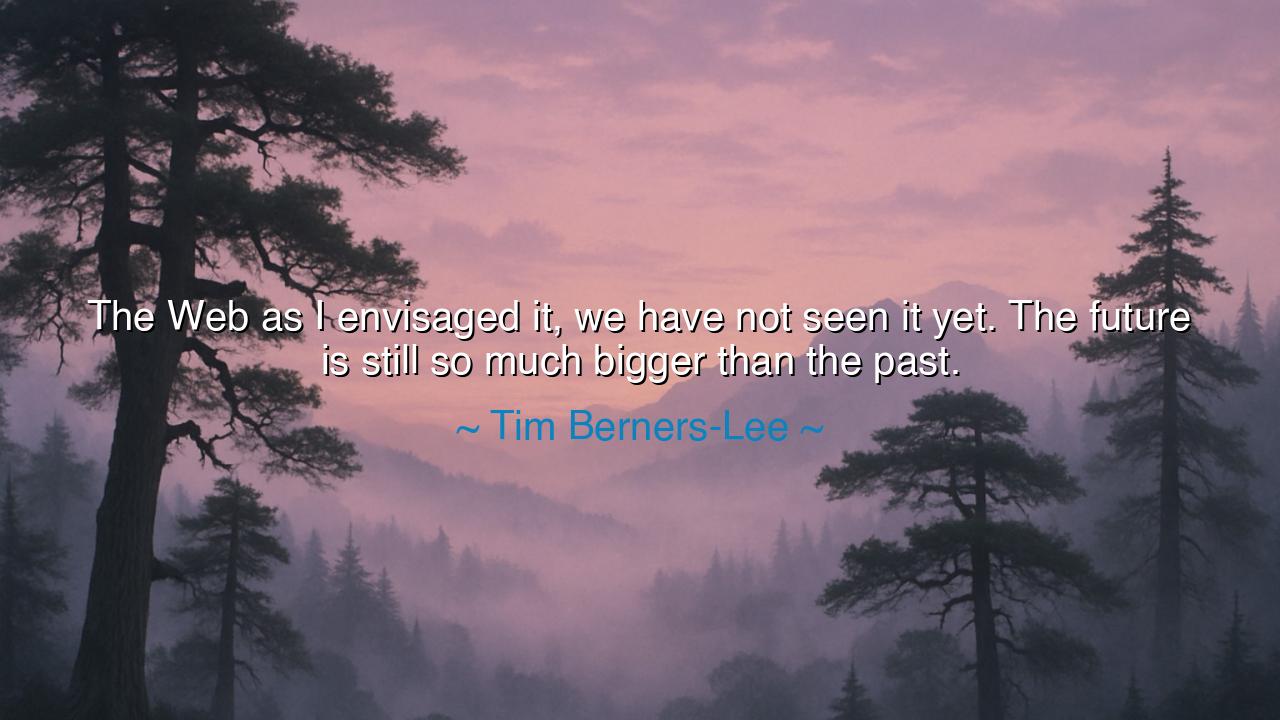
The Web as I envisaged it, we have not seen it yet. The future is
The Web as I envisaged it, we have not seen it yet. The future is still so much bigger than the past.






In the annals of human progress, there are moments when the future whispers in our ears, and we hear it not as a distant echo, but as a call to transform the present. Tim Berners-Lee, a visionary whose work forever altered the landscape of human connection, captured this spirit when he proclaimed, “The Web as I envisaged it, we have not seen it yet. The future is still so much bigger than the past.” In these words lies the seed of all great revolutions—the understanding that the work of the present is but a glimpse of the greatness that lies ahead. The Web, that which has shaped our lives in ways unimaginable a mere generation ago, is not the final vision—it is the beginning of something far greater, a power that is still unfolding, still expanding beyond what we can comprehend.
When Berners-Lee first conceived of the World Wide Web, he envisioned a platform of boundless connection, where information could flow freely and ideas could travel faster than the speed of light. The Web, in its infancy, was merely the foundation—a building block. Yet, even in those early days, Berners-Lee could see beyond what was possible. His words reflect the eternal truth of innovation: that the true power of an idea does not reside in what it is today, but in what it can become. The Web we use today is but a fraction of the potential he glimpsed in the quiet moments of creation, and that potential grows ever greater as time marches on.
This insight into the nature of progress—the recognition that the future is always bigger than the past—is not limited to the Web alone. It is a universal principle of growth. Consider the great explorers who journeyed beyond the horizon, propelled not by certainty, but by the belief that the future contained uncharted lands. Christopher Columbus, who sailed into the unknown, did not know what he would find, but he trusted that there was more—always more—waiting just beyond the edges of the map. And so it is with the Web: though we have explored its vast oceans, we are still at the very threshold of its true potential. We cannot see all that it will become, but we know it will be vast, ever-expanding, and full of surprises.
Berners-Lee’s words also speak to the nature of human ambition—our innate desire to create, to build, and to dream of what has not yet been. When we look at the Web today, we see a world interconnected—ideas, businesses, and people united across great distances. But the Web is not static; it is a living, breathing force that will continue to grow and evolve. We are on the cusp of new technologies—artificial intelligence, virtual reality, and the continued expansion of the Internet of Things—all of which will serve as the next chapter in this great story. What we see today is but a glimpse of what will unfold in the years to come, and the possibilities are as endless as the stars themselves.
Consider the lessons of the past, and how they illuminate the path forward. The invention of the printing press in the 15th century, for example, revolutionized the way knowledge was shared and disseminated. At the time, few could have foreseen the global changes that would come in its wake. It sparked the Renaissance, the Age of Enlightenment, and the profound social shifts that followed. The Web, too, is a tool that will shape the future in ways we cannot yet fully comprehend. Just as the printing press was a catalyst for a new era of thought and innovation, so too is the Web a catalyst for a new age of human potential.
And so, we must look to the future with eyes full of wonder and anticipation. The Web is still young, still unfolding, and its greatest moments have yet to come. This is where Berners-Lee’s wisdom can guide us: that the future will always surpass the past. Just as Columbus did not stop at the shores of the new world but pressed forward into the unknown, so must we continue to embrace the future with open hearts and minds. We cannot know exactly what lies ahead, but we know that it is bigger, more connected, and more full of promise than anything we have yet seen.
The lesson is clear: do not let the present define the limits of possibility. The Web, as we see it today, is merely a foundation—a glimpse into what is to come. The true power of innovation lies not in what we have already created, but in what we have yet to imagine. Let us take this to heart and continue to build, to dream, and to reach for the future. The path ahead is vast and limitless; the Web is but one chapter in the story of progress. The question is not what we have done, but what we are yet to do. So, let us move forward with courage and vision, knowing that the future is far greater than the past, and that we are its creators.






AAdministratorAdministrator
Welcome, honored guests. Please leave a comment, we will respond soon